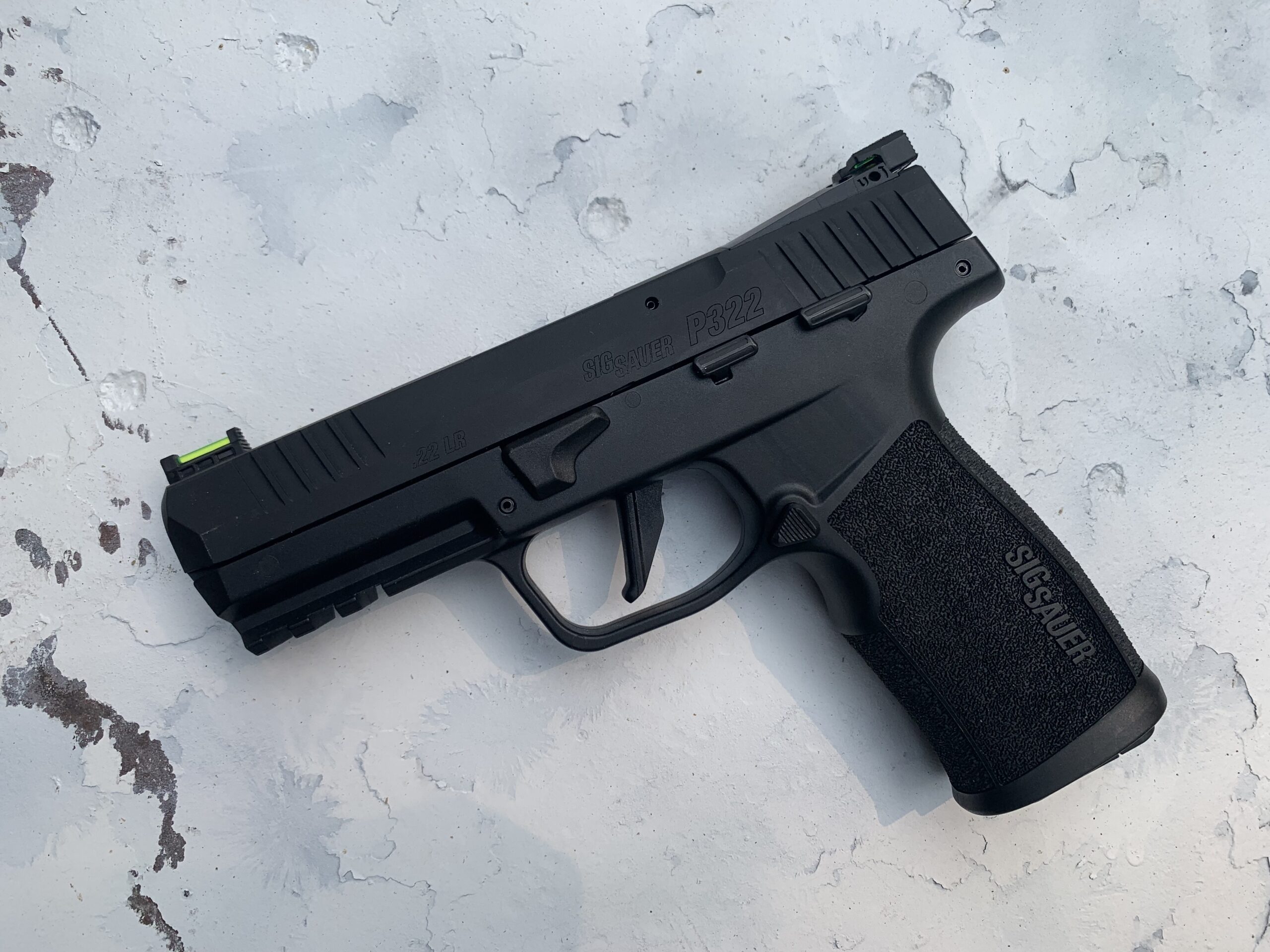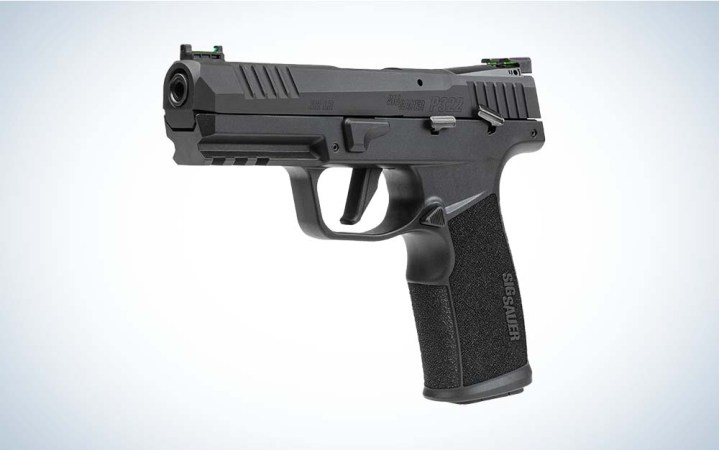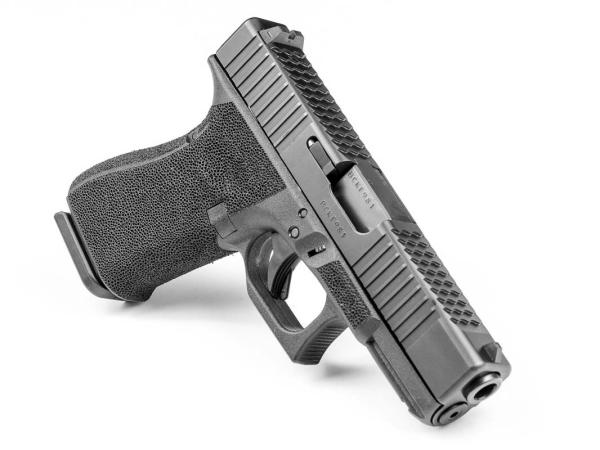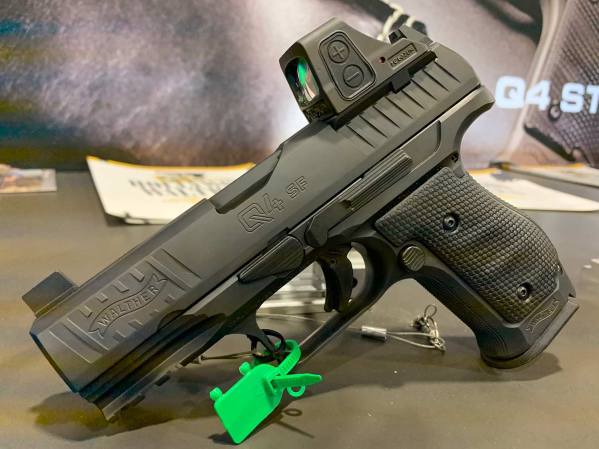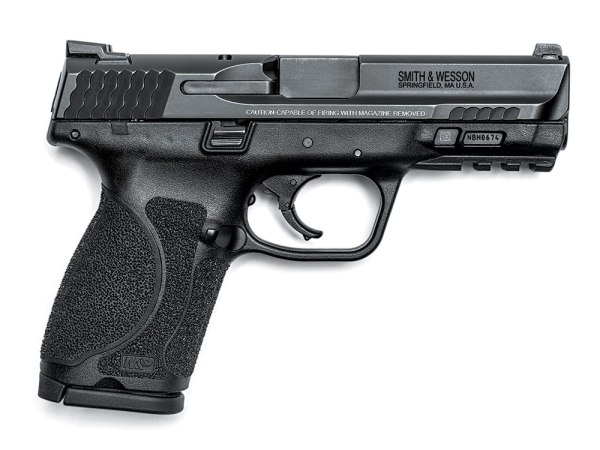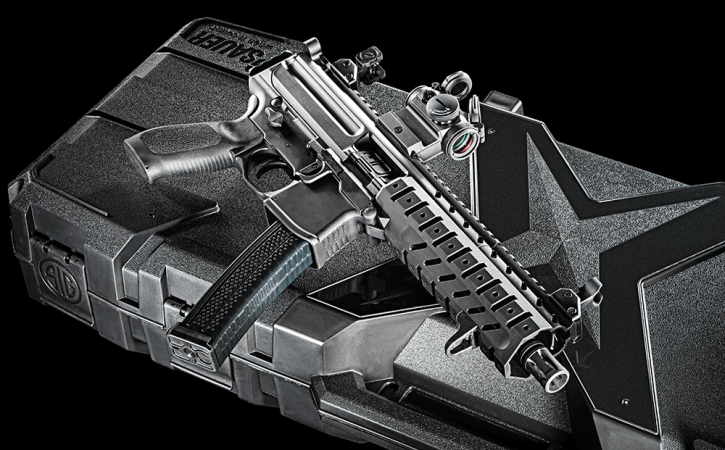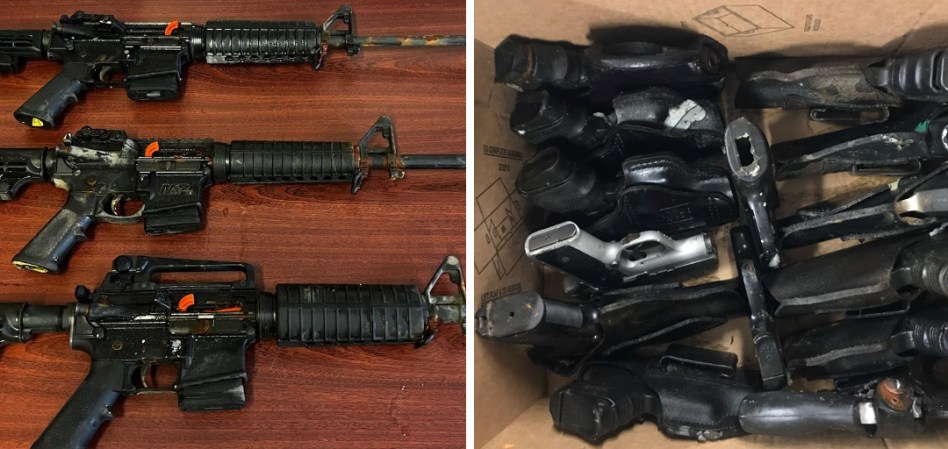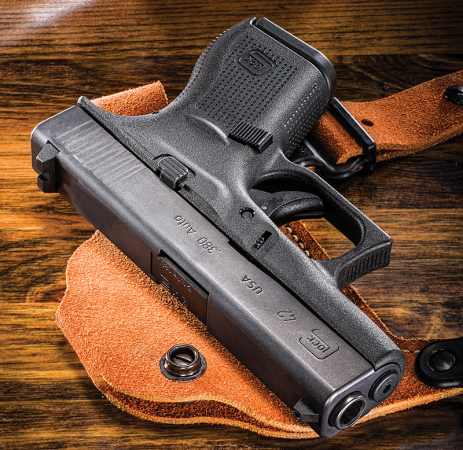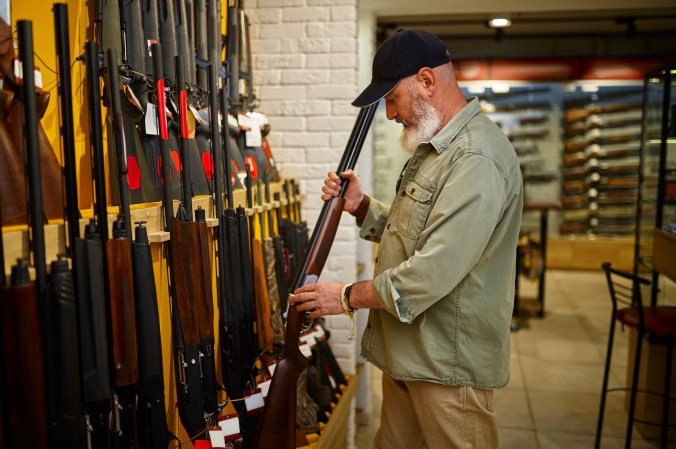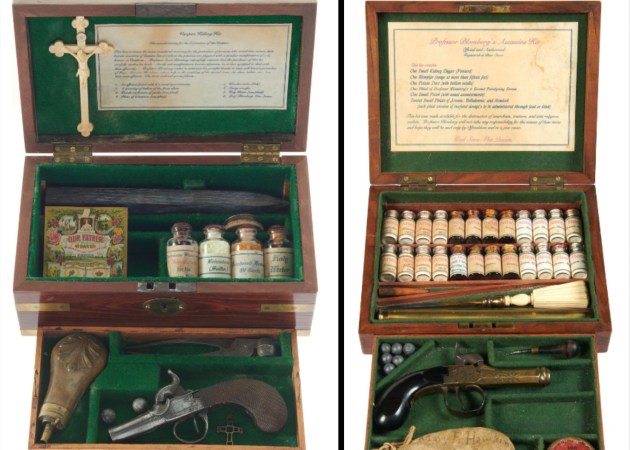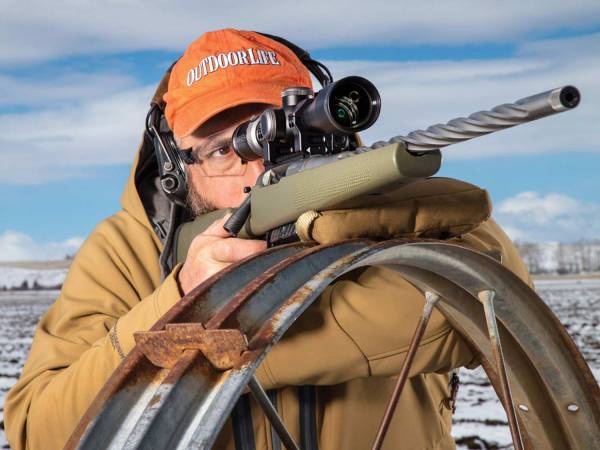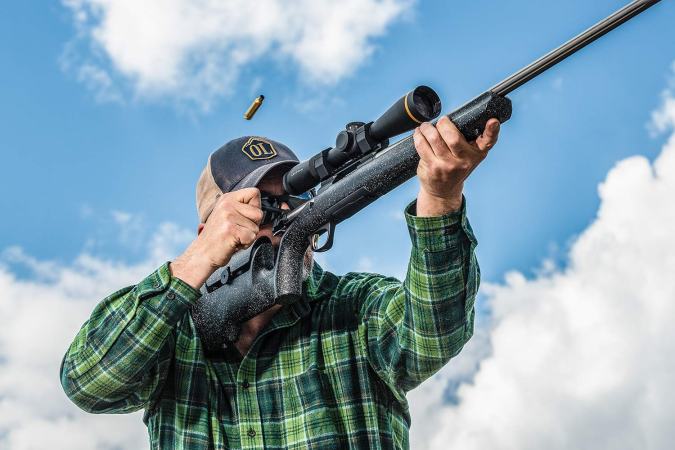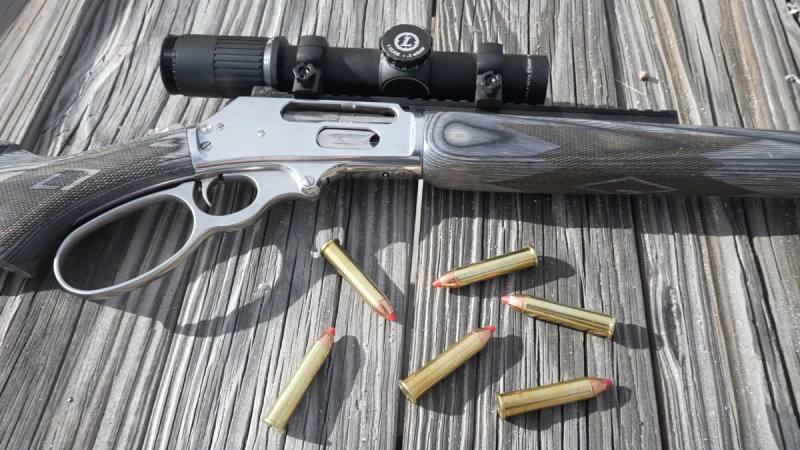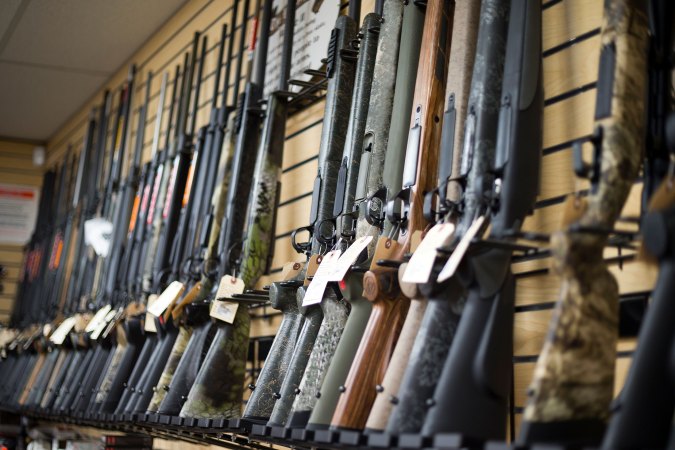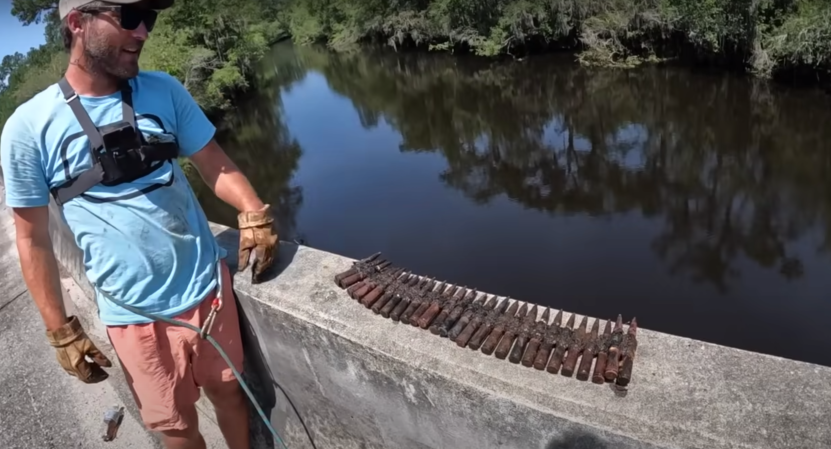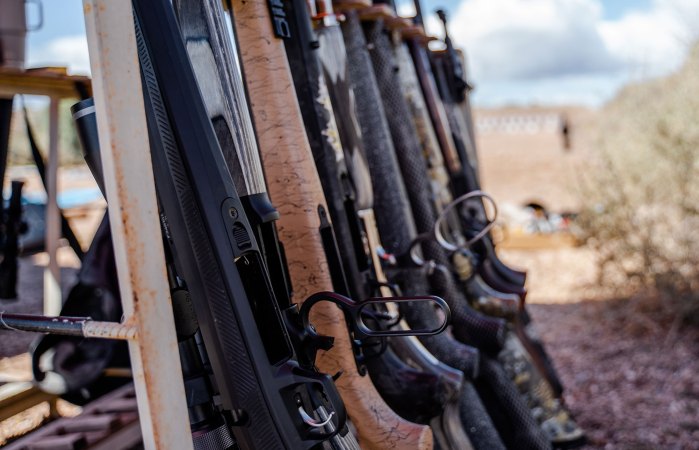We may earn revenue from the products available on this page and participate in affiliate programs. Learn More ›
Although few .22 rimfire pistols hit the market with a big splash, the rollout of the Sig P322 early in 2022 has drawn a lot of attention. Sig Sauer has been rolling out line extensions of its popular pistols at a feverish pace for years, but the P322 represents an entirely new effort and is the company’s only currently-manufactured .22 LR pistol.
Creating a successful .22 pistol can be a tricky affair. Long-standing pistols like the Ruger MK series and Browning Buck Marks offer stiff competition. Several smaller semi-autos like the Walther P22 and Browning 1911-22—that are scaled down for the .22 LR cartridge—crowd the field further.
A Modern Trainer
Full-size .22 pistols designed to mimic the feel of popular centerfire models aren’t a new idea, and there have been numerous full-size 1911-22 clones produced—none of which really stand out as exceptional. Walther has produced them under Colt license, as well as other companies like Chiappa. The idea of a full-sized trainer pistol in the relatively inexpensive and soft-shooting .22 LR cartridge has merit, and it’s this niche of the full-size trainer-type .22 pistol that the Sig P322 grapples for. Already, there are a variety of holsters available for the P322, both IWB and OWB, and even competition holsters. Some initial offerings are from Sig Sauer and Vedder Holsters. Having a good holster is important for quality training.
The Sig P322 bears a striking resemblance to the popular P365 series of micro-compact 9mm’s, but is dimensionally a full-size pistol. It’s got just about every contemporary feature to make it a realistic trainer and potentially raise the bar for polymer .22 pistols. It comes right out of the box ready to be outfitted with an optic, light, and suppressor. At around $400, it’s competitive in its class. It’s closest competitor would likely be the Taurus TX 22, and although the Sig P322 is about a hundred bucks more, it does feature 4 additional rounds of capacity compared to the TX 22’s 16 rounds, as well as being optics-ready.
I was eager to hit the range with the P322 and fired approximately 1,200 rounds during the course of testing. I tried more than a dozen different .22 LR loads, and fired the pistol with and without a suppressor, and with and without a red dot optic.
Sig Sauer P322 Specs
- Caliber: .22 LR
- Capacity: 20+1
- Action: semi-auto, recoil-operated, hammer-fired
- Barrel: 4-inch, carbon steel, threaded
- Dimensions: 7 inches (L) x 5.5 inches (H) x 1.4 inches (W)
- Weight: 17 ounces
- Frame: Polymer/ stainless-steel
- Accessory Rail: 3-slot M1913
- Slide: Aluminum alloy, black anodized finish
- Optics: Romeo Zero optics-cut-slide with removable rear sight/cover plate
- Controls: Ambidextrous safety, slide stop, and reversible magazine catch
- Grip: Polymer, stipple-texture, non-adjustable
- Sights: Fiber optic 3-dot, adjustable rear
- Trigger: Interchangeable flat and curved trigger shoes, single-action, 3 pounds, 9 ounces (measured)
Sig P322 Design and Features
Familiar Look and Feel
Externally, the Sig P322 looks like an up-sized P365. It has a nearly identical-looking frame, grip, trigger, and slide. There are several notable differences though—primarily that the P322 is larger than even the P365 XL. Other significant differences are that the P322 has a 3-slot full-sized M1913 accessory rail and polymer fiber-optic sights.
The front sight is screw-attached rather than dovetail, and secured from the inside of the frame. The fully adjustable rear sight is incorporated into a polymer optic cover plate atop the frame. The rear sight is adjustable for windage and elevation via small flat head adjustment screws. Other minor external differences include the takedown lever, slide-stop, safety, and the front cocking serrations on the slide. The front cocking serrations are located on the top half of the slide and provide excellent traction. Front cocking serrations on the similar-looking P365 are located lower on the slide.
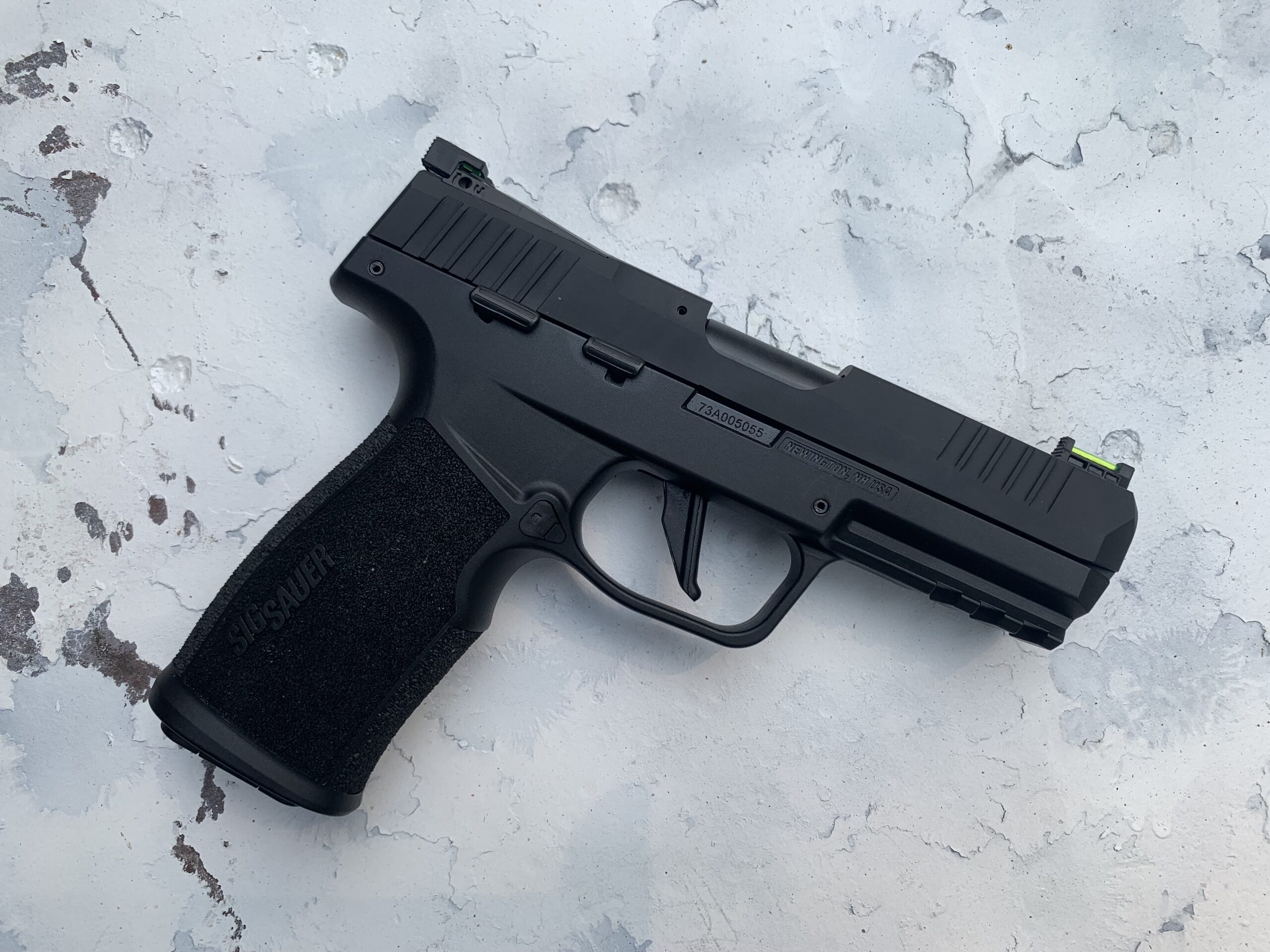
The Sig P322 Increases Capacity and Ditches the Magazine Disconnect
One of the banner features of the Sig P322 is it’s 20+1-round capacity. With few exceptions, almost all semi-auto .22 pistol magazines have been limited to 10 rounds due to the design of the rimmed cartridge itself. Single-stack magazines have long been the standard for .22 pistols because of the way the rimmed .22 LR cases stack on top of one another. Most .22 pistol magazines are angled forward to allow the case rim to stack in front of the rim on the cartridge below it. The magazine of the P322 is successful in using a double-stack design and it has a more vertical orientation than most other .22 magazines.
The P322 uses a polymer double-stack magazine with follower buttons protruding from both sides of the magazine body. Use these to depress the magazine spring and easily load the 20 rounds of ammunition. The pistol comes with a spare magazine and loading tool that depresses the magazine follower and will save your thumbs on high-volume days. A 20-round capacity is overdue for .22 pistols, and the Sig P322 magazine seems to do a good job at tackling the challenges of the rimmed case.
In addition to the excellent capacity, shooters will like the absence of a magazine disconnect—a mechanism that prevents the pistol from being fired without a magazine fully installed. Many semi-auto .22 pistols utilize a magazine disconnect, and the lack of one makes the Sig Sauer P322 a bit more shooter-friendly and similar to centerfire pistols.
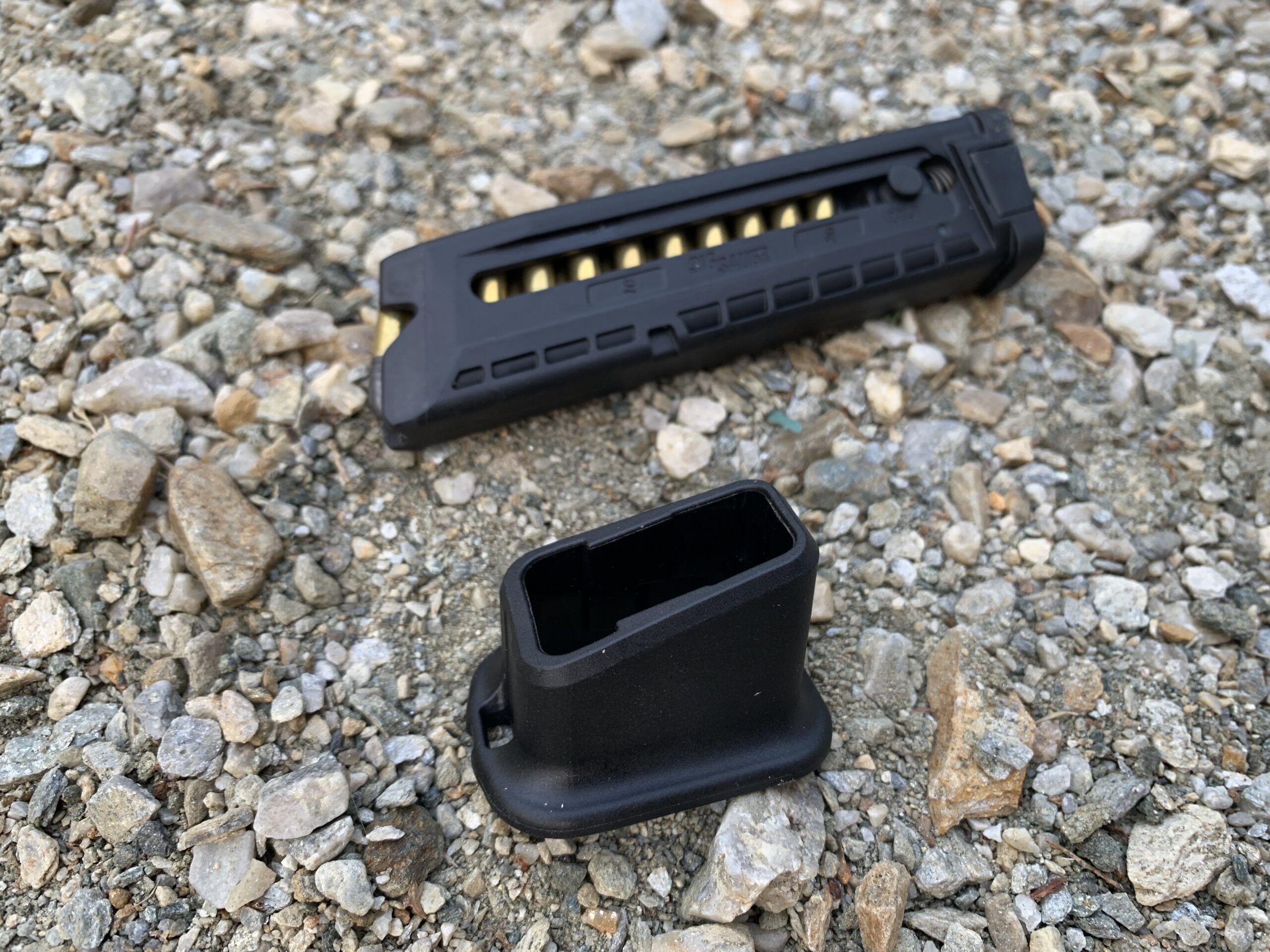
Ambidextrous Controls and Interchangeable Parts
External controls on the Sig P322 are simple, low-profile, and ambidextrous. The pistol has slide stop and safety levers on both the left and right side, and the magazine catch button is reversible. Aside from the takedown lever—which is located on the left side of the frame—there is no discernible difference in feel between left-handed and right-handed shooting.
The Sig P322 also comes with interchangeable trigger shoes. In the style of many of Sig’s other pistols, the P322 comes with a flat trigger shoe installed, but it includes a curved trigger shoe that’s easily swapped out if that’s what you prefer.
The 4-inch barrel of the Sig P322 is flush with the front of the slide. The barrel is threaded and comes with a small thread protector installed. It also includes a ½x28 adapter that extends beyond the front of the slide for using a suppressor.
Sights and Optics on the Sig Sauer P322
The Sig P322 comes optics ready, with the factory rear sight built into the polymer plate that covers the optics cut on the slide. The slide is cut to fit a Sig Romeo Zero red dot without the use of any adapter plates, and I was able to fit mine with a Holosun HS407K X2.
The fiber-optic sights on the P322 aren’t on the same level as the factory sights of some of Sig’s centerfire pistols, but the rear sight is fully adjustable for windage and elevation via small Allen key screws.
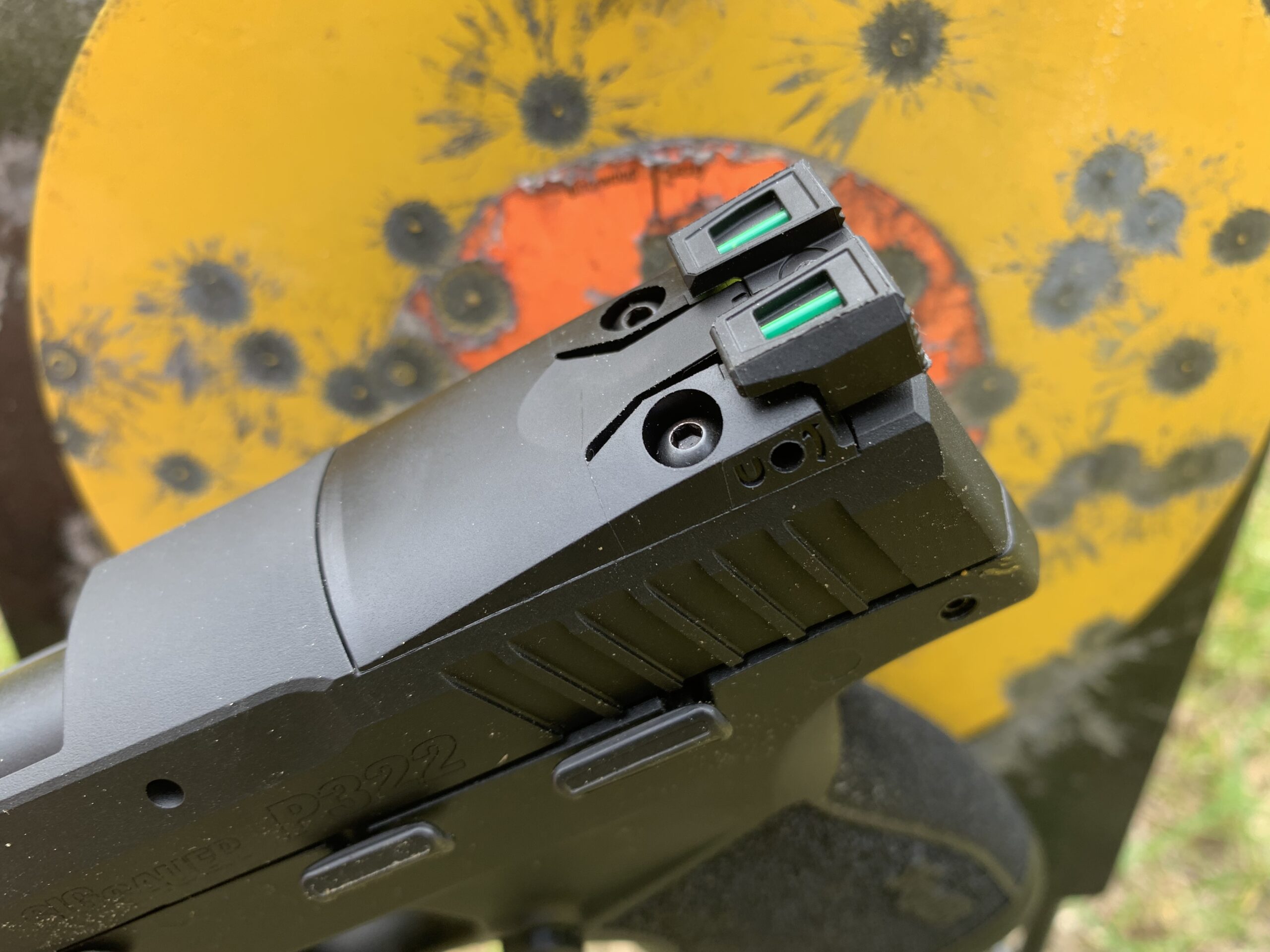
Under The Hood of the Sig Sauer P322
Despite looking strikingly like a large P365, the Sig P322 has an entirely different internal design. The most significant internal design feature is that the P322 use a fixed-barrel. This is common in semi-auto .22 pistols and seems to work well for the P322. The barrel is pinned into a stainless-steel shroud which secures it to the frame. The shroud is what you see through the ejection port when the slide is closed.
Field-stripping the P322 is simple. After you remove the slide, the recoil spring is held in place on the barrel by a small, rounded bushing that’s retained by the thread protector on the muzzle. When you are using the suppressor adapter, the slide cannot be removed from the barrel with the adapter installed. To field strip when using the suppressor adapter, verify the gun is unloaded and lock the slide back. Remove the suppressor adapter and replace it with the original thread protector. That will keep the recoil spring and bushing on the barrel during cleaning.
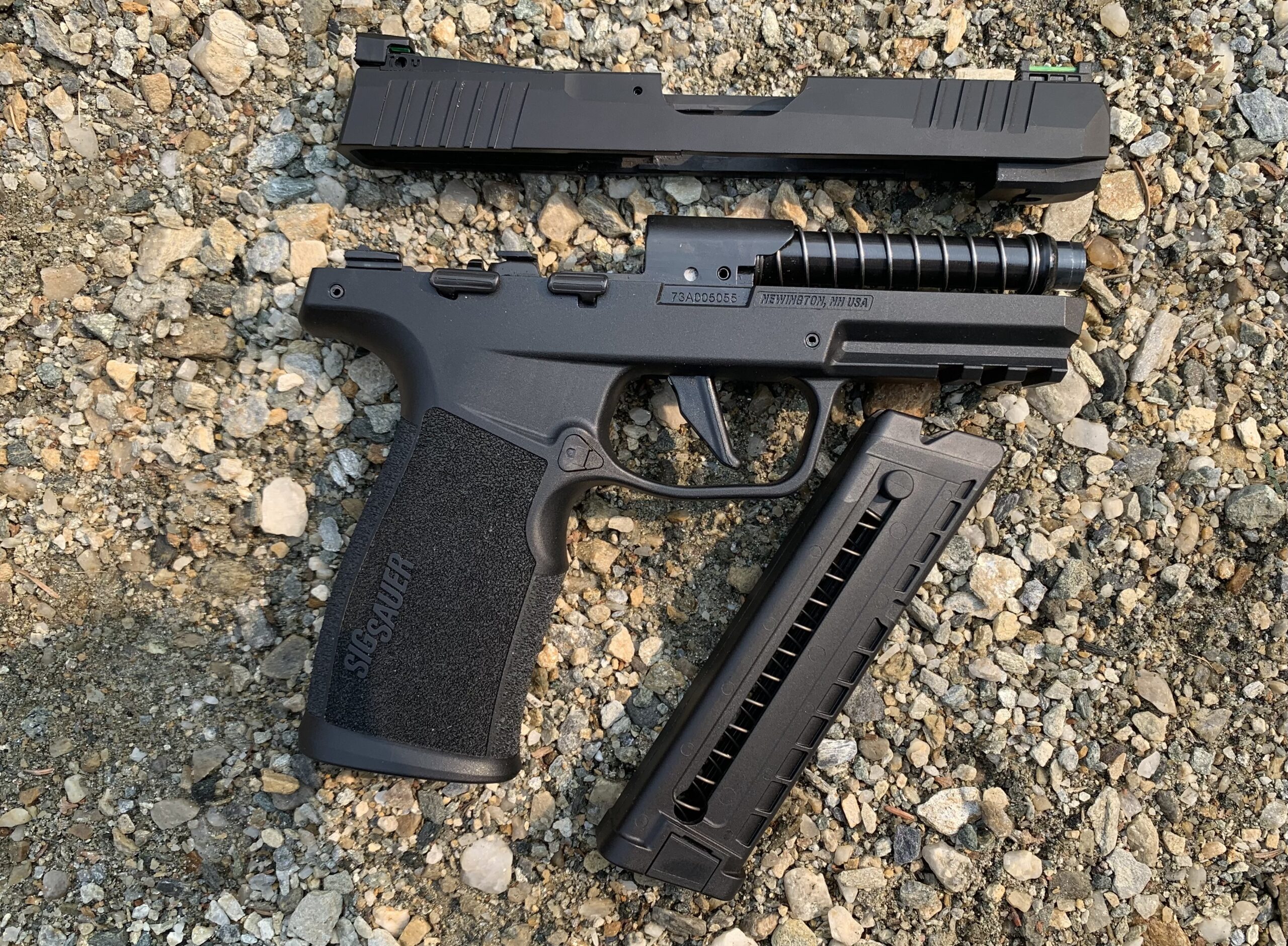
Aside from the fixed barrel, I noted that the ejector is beveled nearly to a chisel-sharp edge—which seems to result in strong ejection of cases. In fact, when manually ejecting live rounds, it would pitch them out farther than I could catch them. Another variation in design from the centerfire P365 and P320 series is that the P322 does not feature a complete and easily-removable fire control group—something that would be a help when cleaning the pistol.
Another notable characteristic of the Sig P322 is that it’s hammer-fired, not striker fired. It features a concealed hammer in the rear of the frame, which rotates through a hollowed space at the rear of the slide to strike the firing pin. The slide is aluminum alloy but appears to have a steel insert that houses the firing pin, extractor, and supports the case head. The only downside I found to this fixed-barrel, hammer-fired design was that when cleaning with a rod, the cleaning rod tends to scrape on the hammer, and the hammer must be depressed slightly to have good alignment with the bore.
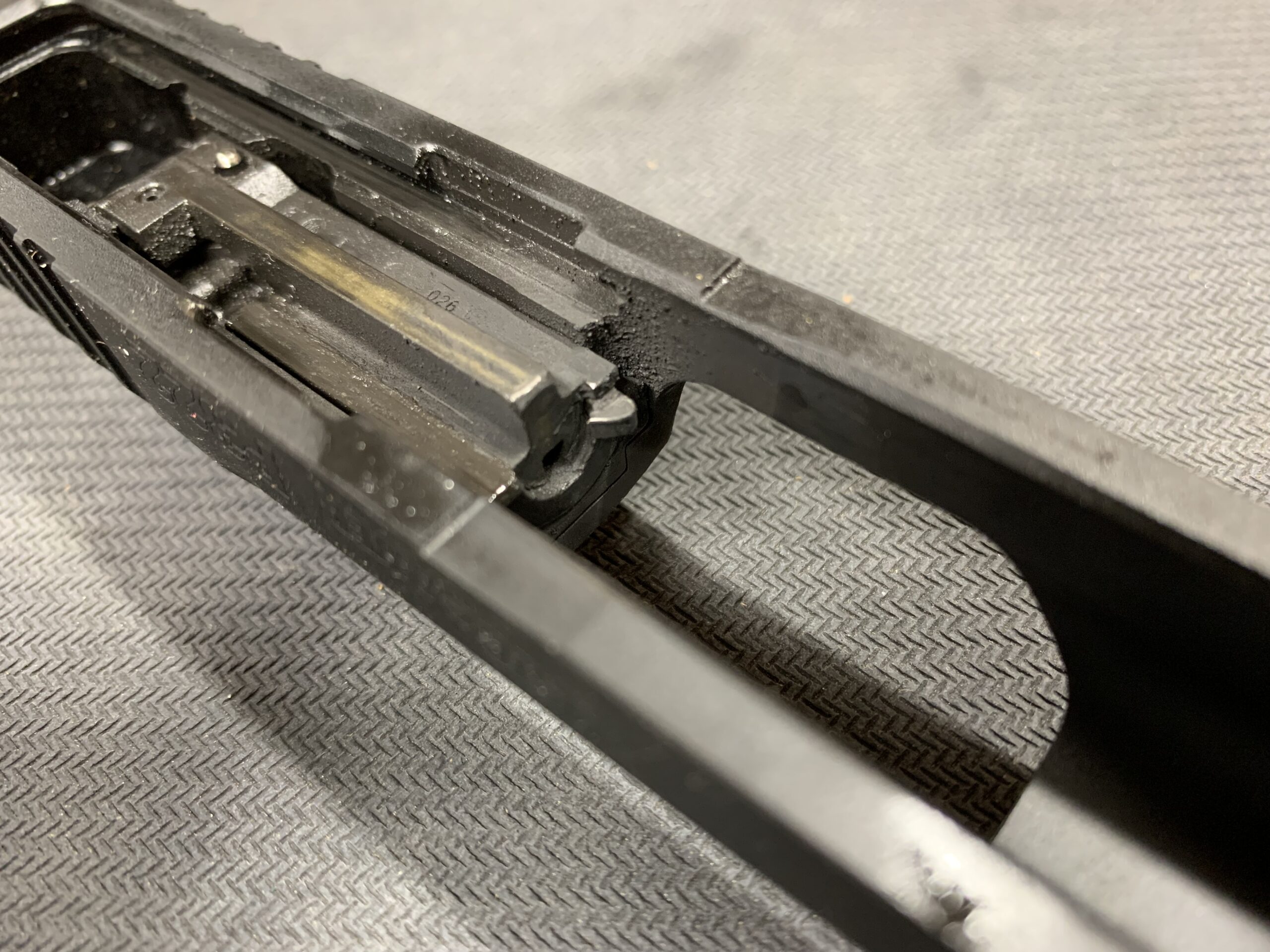
The Sig Sauer P322 In the Hand
The most noticeable handling trait of the Sig P322 is the weight—which is lighter in the hand than centerfire pistols of similar size. Despite being a larger pistol than the P365 9mm series, the P322 weighs just over a pound empty. Its light compared to its centerfire counterparts because of the smaller, lighter barrel and aluminum slide. Although it’s light, the balance of the pistol is good.
I found the P322 to be comfortable to hold, and the semi-aggressive stipple texturing provides a secure grip. Like the P365 and P320 X-series frames, the P322’s frame features a single groove under the trigger guard. This helps the user choke up on the pistol and get a tight grip with the middle-finger without interfering with the magazine catch button.
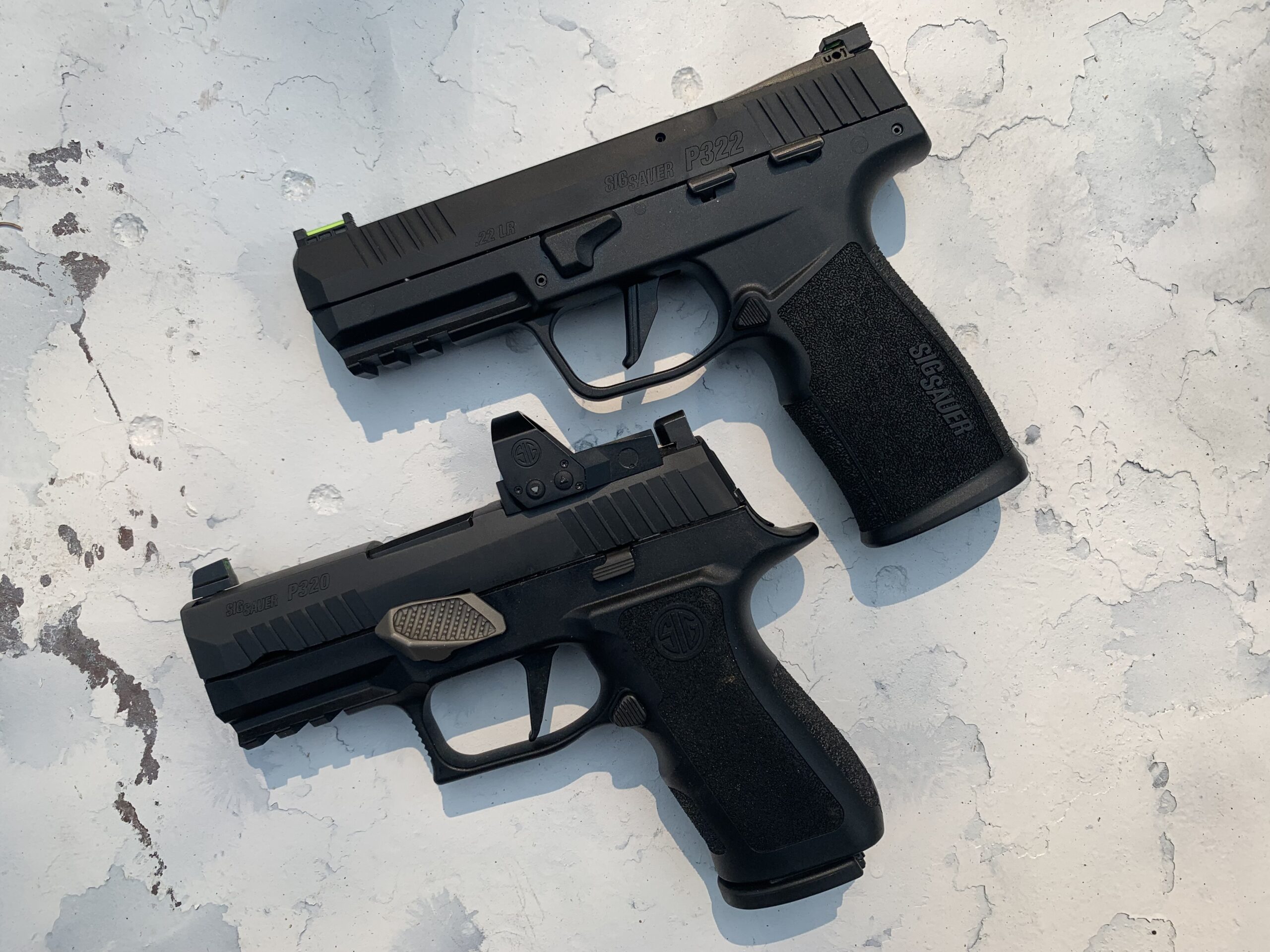
It’s easy to build a good, repeatable grip with this pistol, and I found it pointed very naturally. My only gripe with the ergonomics is that the trigger is a bit more of a reach than is comfortable. The middle of the flat trigger shoe on the Sig P322 sits almost 3/8 of an inch farther forward from the rear of the grip than the similar triggers on both P320 9mm’s I have. It’s not a deal-breaker but gives a sensation of having to reach forward for the trigger. It’s not easy to get your finger inside the trigger guard without touching the trigger—the movement needs to be deliberate.
The frame features a beveled magwell that makes reloading the Sig P322 a breeze. Magazines are easy to load into the frame and can be seated with little pressure. The grip, magazines, and feel of reloading are similar enough to full-size centerfire pistols to make the P322 a realistic training tool for practicing quick reloads.
The trigger on my sample breaks at an impressively light 3 pounds, 9 ounces according to my Lyman trigger pull gauge. However, the trigger has a large amount of travel—both to the break and back to the reset. Despite the travel, the trigger is smooth through the break, and has good spring tension driving it back to the reset—which is crisp and tactile.
Accuracy and Reliability of the Sig P322
In-all, I fired approximately 1,200 rounds of various .22 LR ammunition through the Sig P322 and found it to be accurate and reliable. I’d had major accuracy issues with the Sig Mosquito pistol in the past, and nearly pitched mine into the bushes after missing a ptarmigan with an entire magazine. I found that the P322 shot well with a variety of subsonic, standard-velocity, and high-velocity ammunition.
The P322 Is Smooth-Shooting and Accurate
The Sig P322 isn’t designed to be a bullseye pistol, so I didn’t treat it like one. I found trigger control to be the biggest factor in accuracy with this pistol. With prudent application of such trigger discipline, I had no problem piling whole magazines into 2- to 3-inch groups on steel at 25 yards with two hands, unsupported. The nearly nonexistent recoil allows for fast and fun shooting—especially on a variety of steel targets.
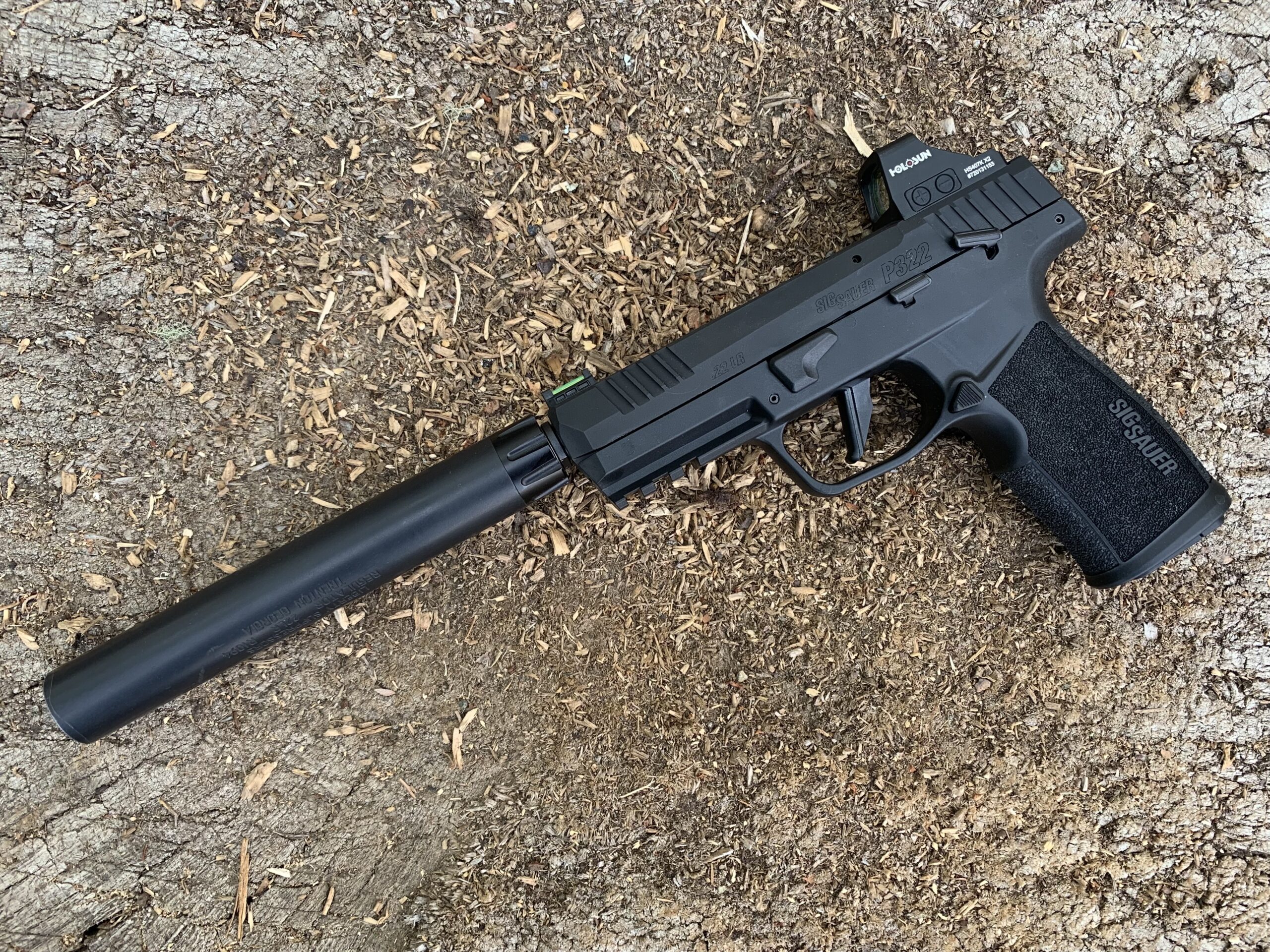
Loading and Cycling
I found that the magazines loaded easily—and even easier to empty. Despite the dramatic shift from traditional single-stack magazines, the P322 fed perfectly for several hundred rounds at a time. Rimfire ammunition is inherently filthy, and fouling piles up quickly. Once the wax and grime accumulated on the slide and in the chamber, I had some slow, gummy feeding. A few cleaning patches and a quick wipe-down remedied the issue.
I experienced a couple of misfires when the pistol was dirty—potentially light primer strikes due to fouling around the firing pin. I was shooting A Ruger Mark IV alongside the P322, and I had more misfires (and several malfunctions) with the Ruger than with the Sig—something that surprised me. Throughout my testing, I never experienced a failure to eject, and the only malfunctions I saw were due to the pistol being severely dirty—a fact of life with .22 pistols.
Many .22 pistols are finicky and won’t cycle certain brands or loads of ammo as well as others. I didn’t see this kind of pickiness with the Sig P322 and everything cycled smoothly. One load gave me a bore-fouling issue, but cycled just fine. It seemed to digest everything I could throw at it. I used a variety of loads from CCI, including their Standard Velocity 40-grain, Blazer, Mini-Mag, and the high-velocity Stingers shot especially well. It also liked Federal American Eagle, Browning Pro-22 and Norma Tac 22. With a suppressor, subsonic loads like Eley Contact, Norma Subsonic 22, and Sellier & Bellot Subsonic were stupid quiet and abhorrently fun to shoot.
Fouling Frustration—Test Your Ammo
The only frustration I had with the Sig P322 ended up being an issue with one type of ammunition—Winchester Super X 40-grain Power Point. After firing around 100 rounds, accuracy deteriorated rapidly. Quickly, I could hardly hit a 50 percent IPSC steel target at 15 yards. Upon inspecting the bore, I found that the last ¾-inch of the bore was caked with lead fouling. It was so bad that I likely would have had a baffle or endcap strike if I’d been using a suppressor at the time.
I cleaned and brushed the fouling out and accuracy returned, then quickly diminished within 100 rounds as the end of the bore leaded back up. After cleaning a second time, I moved on through my selection of ammunition and didn’t encounter the issue again. I investigated the issue further, firing the Super X ammunition through both the Sig P322 and a Ruger Mark IV 22/45—both starting with clean bores. After 80 rounds, the P322’s accuracy began to decay and fouling was easily visible. The Mark IV never experienced any of the fouling issues, indicating that my P322 and that particular ammo just don’t get along. I didn’t see any fouling issues with a dozen other types of ammunition that I tried. It would be wise to check for this issue before you start using a suppressor on the pistol (or any .22 pistols for that matter).
Read Next: M1 Garand: The Greatest Generation’s Service Rifle
Where the Sig Sauer P322 Excels
The Sig P322 is a fun and reliable pistol to shoot, but also a realistic trainer. It has the feel and function of a full-sized pistol. The 20-round capacity is great, and the magazines handle and reload much like 9mm mags. Optic and accessory compatibility also help make this a great out-of-the-box .22 pistol.
Where the Sig Sauer P322 Could Be Better
It would be nice to have the trigger sit a fraction of an inch back farther on the P322. Needing to reach for the trigger—in addition to its long travel—makes precise trigger control a challenge with this pistol. It also makes it difficult to get your finger into the trigger guard without touching the trigger—especially with gloves. The design isn’t the easiest to clean completely either—.22 pistols need more-frequent cleaning than their centerfire counterparts.
Final Thoughts on the Sig Sauer P322
I don’t believe that the Sig P322 is going to be toppling pistols like the Ruger MK IV from their lofty perches in the dedicated 22 pistol market, but it’s probably the best one I’ve seen for a functional trainer. Great practical accuracy and reliability coupled with its rare 20+1-round capacity make it a strong choice for any shooter, and its out-of-box accessory compatibility make it even better. It’s a good value, strong performer, and damned cool.

